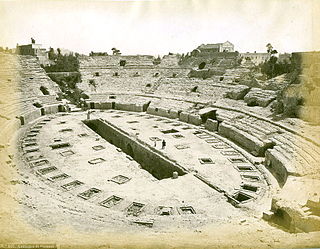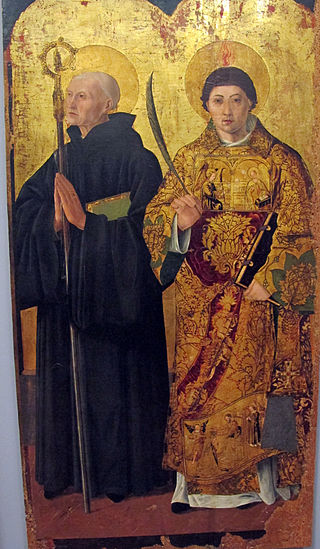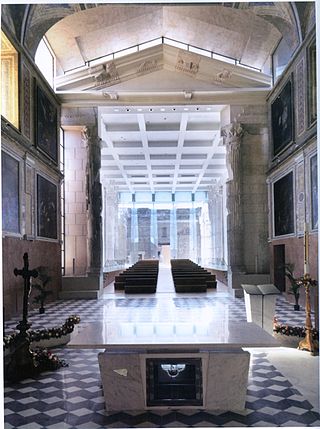Year 305 (CCCV) was a common year starting on Monday of the Julian calendar. At the time, it was known as the Year of the Consulship of Constantius and Valerius. The denomination 305 for this year has been used since the early medieval period, when the Anno Domini calendar era became the prevalent method in Europe for naming years.

Solfatara is a shallow volcanic crater at Pozzuoli, near Naples, part of the Phlegraean Fields volcanic area. It is a dormant volcano, which still emits jets of steam with sulfurous fumes. The name comes from the Latin, Sulpha terra, "land of sulfur", or "sulfur earth". It was formed around 4000 years ago and last erupted in 1198 with what was probably a phreatic eruption – an explosive steam-driven eruption caused when groundwater interacts with magma. The crater floor was a popular tourist attraction until 2017, as it has many fumaroles and mud pools. The area is well known for its bradyseism. The vapours had been used for medical purposes since Roman times.

Januarius, also known as Januarius I of Benevento, was Bishop of Benevento and is a martyr and saint of the Catholic Church, Eastern Orthodox Church, and Armenian Apostolic Church. While no contemporary sources on his life are preserved, later sources and legends claim that he died during the Great Persecution, which ended with Diocletian's retirement in 305.

Pozzuoli is a city and comune (municipality) of the Metropolitan City of Naples, in the Italian region of Campania. It is the main city of the Phlegrean Peninsula.

Sep. 18 - Eastern Orthodox liturgical calendar - Sep. 20

Saint Proculus (Proclus) of Pozzuoli was martyred around 305 AD, according to Christian tradition, at the same time as Saint Januarius.

The statue of Saint Proculus was created by Michelangelo out of marble. Its height is 58.5 cm. It is situated in the Basilica of San Domenico, Bologna. Its subject is Saint Proculus, a martyr of Bologna.

Saint Proculus of Bologna or Saint Proculus the Soldier is an Italian saint. He is said to have been a Roman officer who was martyred at Bologna under Diocletian.
Proculus was a Roman usurper against Emperor Probus in 280.
Miseno is one of the frazioni of the municipality of Bacoli in the Italian Province of Naples. Known in ancient Roman times as Misenum, it is the site of a great Roman port.

The Diocese of Pozzuoli is a Latin diocese of the Catholic Church in Campania, southern Italy. It is a suffragan of the Metropolitan Roman Catholic Archdiocese of Naples, like its other neighboring dioceses, Aversa and Ischia.

The Flavian Amphitheater, located in Pozzuoli, is the third-largest Roman amphitheater in Italy. Only the Roman Colosseum and the Amphitheatre of Capua are larger. It was likely built by the same architects who previously constructed the Roman Colosseum. The name "Flavian Amphitheater" is primarily associated with the Roman Colosseum.

Saint Sossius or Sosius was Deacon of Misenum, an important naval base of the Roman Empire in the Bay of Naples. He was martyred along with Saint Januarius at Pozzuoli during the Diocletian Persecutions. His feast day is September 23, the date, three days after his death, on which his corpse was translated to Misenum.

San Procolo is an early Gothic-style, Roman Catholic church and former monastery-hospital located on Via Massimo D'Azeglio #52 in central Bologna, region of Emilia Romagna, Italy.

San Procolo is a Paleo-Christian, Roman Catholic small temple standing adjacent to the Basilica di San Zeno in central Verona, region of Veneto, Italy.

Pozzuoli Cathedral or the Basilica of San Procolo martire is the main Roman Catholic church in Pozzuoli and the seat of the Diocese of Pozzuoli. It sits at the top of the Rione Terra and is built around an ancient Roman temple.

Saint Januarius in the Amphitheatre at Pozzuoli is a 1635-1637 oil on canvas painting by Artemisia Gentileschi. The work shows the moment that the Christian martyr Januarius and his followers are thrown to a group of wild animals in the amphitheatre in Pozzuoli - however, they lick the saint's feet rather than attacking him and Januarius is unharmed.

Adoration of the Magi is a 1635–1637 painting by Artemisia Gentileschi. Along with Saint Januarius in the Amphitheatre at Pozzuoli and Saints Proculus and Nicea, it was commissioned by Martín de León Cárdenas, bishop of Pozzuoli for Pozzuoli Cathedral. Adoration was held in Naples for around fifty years for conservation before being returning to its original position in the Cathedral in May 2014.

Saints Proculus and Nicea is a 1635-1637 painting by Artemisia Gentileschi of Proculus and Nicea. Along with Adoration of the Magi and Saint Januarius in the Amphitheatre at Pozzuoli, it was commissioned by Martín de León Cárdenas for the choir of Pozzuoli Cathedral, of which he was bishop. After around fifty years' restoration in Naples, the painting was returned to its original spot in May 2014 when the Cathedral reopened for worship.
This page is based on this
Wikipedia article Text is available under the
CC BY-SA 4.0 license; additional terms may apply.
Images, videos and audio are available under their respective licenses.














